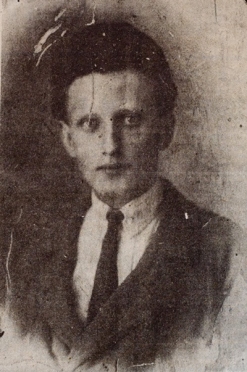
Beauty in Hell: Culture in the Gulag is an online exhibition at The Hunterian at the University of Glasgow on one of the Soviet Union’s earliest prison camps, Solovki. Recently, B O D Y published a poem by a former Solovki inmate Yury Kazarnovsky, “Tram“, and an example of some of the amazing cultural and intellectual activity that came out of the camp. Exhibition curator Andrea Gullotta talked to Literalab about his research and the uniqueness of the camp’s place in the history of the Gulag.
Literalab: Were there significant differences between Solovki and later Gulag camps, and if so, what were they?
Andrea Gullotta: The Solovki prison camp was unique in the history of the Soviet camps. It was entrusted to the OGPU (i.e. the former Cheka) with the specific objective of creating a system of exploiting the prisoners’ forced labour in a profitable way. For this reason, it has been considered the laboratory of the Gulag: the techniques adopted on Solovki (especially Naftalii Frenkel’s idea of using forced labour not only within the camp, but also for commercial, economic and building activities outside of it) were then exported to the whole system of camps during its expansion in the 1930s, and remained in power for many years.
The experimental status of the Solovki prison camp created a unique situation: while horrible crimes, tortures and punishments were inflicted on the prisoners, a few of them were used in cultural activities which were in theory supposed to celebrate the Soviet system. However, thanks to a series of particular conditions, the cultural output of the camp was incredibly free, to the point that most prisoners used the possibility of expressing their creativity to fight the system that was crushing them. It is to this outstanding example of cultural resistance, and to these remarkable people, that the exhibition is to devoted.

Literalab: How much scholarship is there on this subject, both inside and outside of Russia?
Gullotta: A huge deal of work has been done on the theme, but not much of it is academic. The history of the camp was well-known thanks to the memoirs left behind by its prisoners – among whom was Dmitrii Likhachev, one of the most outstanding Russian medievalists – and by Aleksandr Solzhenitsyn, who took the Solovki archipelago as a metaphor for the whole system of Soviet camps in his The Gulag Archipelago. People like the photographer Iurii Brodskii (who is now going through a hard time for his work on the Solovki, and to whom I would like to express my support) have worked extensively on the topic, while other intellectuals – e.g. the writers Zakhar Prilepin and Evgenii Vodolazkin, as well as the French film director Olivier Rolin and, before him, the Russian film director Marina Goldovskaia – have been interested in the Solovki prison camp to the point that it has inspired their creative work. In terms of academic work, apart from works that I would not recommend to read, Natalia Kuziakina’s Theatre in the Solovki Prison Camp is the only monograph entirely devoted to the camp, while other books – such as Anne Applebaum’s Gulag: A History or Roy Robson’s Solovki: The Story of Russia Told Through Its Most Remarkable Islands – devote large space to it.
Literalab: Of all the figures you came across who worked or were imprisoned in the Solovki is there one in particular who stands out for you? And of all the intellectuals who created work while imprisoned, whose work is the most compelling for you?
Gullotta: I admit this is a very difficult question for me. The Solovki prison camp, alas, was populated by many people, including a high number of brilliant intellectuals. I have studied their biographies and their works for almost ten years, and in a way I am grateful and feel close to all of them. If I have to mention a few names, I would like to name three: Boris Glubokovskii, actor, playwright, essayist, fiction writer and poet, a multifaceted intellectual who made a terrific impact on the camp’s culture; Vladimir Kemetskii, an outstanding poet, author of impressive sonnets and poems – other than those published in emigration, particularly remarkable are the poems written after his arrest in 1927; and Iurii Kazarnovskii (Yury Kazarnovsky), an incredibly witty humourist and excellent poet, who published a series of parodies on the camp’s internal publications. They all shared a horrible fate, which prevented them to rise to fame.
Photos – 1. Gorky visits Solovki, 2. Yury Kazarnovsky

Trackbacks/Pingbacks
[…] mainland allowed them to develop a unique degree of expressive freedom. As Gullotta said in an interview with Literalab, “the cultural output of the camp was incredibly free, to the point that most […]
[…] mainland allowed them to develop a unique degree of expressive freedom. As Gullotta said in an interview with Literalab, “the cultural output of the camp was incredibly free, to the point that most […]